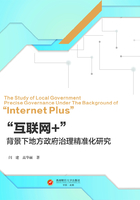
摘要
在“互联网+”背景下,各类社会资源重新整合,社会生产方式和生活方式均发生深刻变革,给政府治理带来了前所未有的压力和挑战。与工业时代传统政府治理“以政府部门自身需求为中心”“各部门独立办事”的治理模式不同,在“互联网+”背景下,政府治理要“以公众需求为中心”,强调政府内部机构和部门整体性运作,为公众提供个性化和精准化服务。“互联网+”的快速发展,为地方政府全面收集公众的公共服务需求信息提供了技术可能性,大大提高了部门间信息传播和交流沟通的效率,使地方政府能够在信息相对充分的条件下做出精准化的治理决策。顺应“互联网+”时代的要求,对政府治理进行精准化变革受到了党和国家的高度重视,国务院专门制订并推进实施了“互联网+”行动计划。
在实践探索中,一些地方政府积极尝试通过“互联网+”技术实现治理精准化,具有代表性的有宁夏回族自治区固原市彭阳县“互联网+”背景下的医疗精准化、江苏省苏州市“互联网+”背景下的养老精准化、四川省成都市“互联网+”背景下的城市管理精准化、贵州省“互联网+”背景下的扶贫精准化和浙江省“互联网+”背景下的政务服务精准化。然而,我们通过问卷调查和实地访谈发现,实践中的地方政府治理精准化普遍存在“以公众需求为导向”的精准化治理理念落实不够,多元主体参与不均和条块分割,公共服务决策数据碎片化、执行效能低下和监督缺乏合力等问题。问题产生的主要原因在于中央与地方政府权力分配冲突和横向利益竞争制约了主体间的协作互动、公众需求表达渠道不畅和供需双方缺乏信任、精准化治理绩效评价中的目标偏差和指标设计不合理、互联网领域的法律供给滞后和立法部门化。
针对以上问题,进行机制创新以在“互联网+”背景下推动我国地方政府决策科学化、治理精准化、服务高效化,从而更好地保障和改善民生,具有十分重要的理论价值及现实意义。本书对“互联网+”背景下不同层级、不同区位、不同服务人群的地方政府精准化公共服务提供过程中的治理主体、治理对象、治理方式、治理过程、治理结果和治理机制等进行了深入研究,构建了地方政府治理精准化的协作互动、服务供给、绩效评价和法治保障子机制。在总体逻辑结构上,本书由总论和分论的“二分结构”构建,总论部分包括第一章和第二章,分论部分包括第三章至第七章。
具体来说,第一章主要是提出研究问题、界定研究问题、研究述评、介绍本书的研究思路方法和逻辑框架;第二章以“治理” “政府治理”“政府治理机制”“互联网+”“‘互联网+’背景下的政府治理”为核心词,对国内外相关研究进行了系统的学术史梳理,以厘清研究的重要主题;第三章阐述了“互联网+”背景下地方政府治理精准化面临的机遇和挑战;第四章在东、中、西部地区的省市县级层面选取了走在全国前列,取得了较好效果,并具有一定推广性的“互联网+”背景下医疗精准化、养老精准化、城市管理精准化、扶贫精准化和政务服务精准化的典型案例进行了剖析;第五章介绍了本研究调查问卷的基本结构、初步设计、问卷检验和问卷形成过程,并对东、中、西部地区6个省份12个市县回收的近千份问卷进行了统计分析;第六章指出了“互联网+”背景下地方政府治理精准化中存在的问题,并探究了产生问题的原因;第七章构建了推动“互联网+”背景下地方政府治理精准化的协作互动子机制、服务供给子机制、绩效评价子机制和法治保障子机制。
Abstract
Under the background of“Internet Plus”, all kinds of social resources have been reintegrated, and profound changes have taken place in social production mode and way of life, bringing unprecedented pressure and challenges to government governance. Different from the governance mode of“traditional government administration centered on the needs of the government departments”and“independent departments acting independently”in the industrial era, under the background of“Internet Plus”, the government should be“centered on the needs of the public”, emphasizing the overall operation of the internal organs and departments of the government, and providing personalized and precise services to the public. The rapid development of“Internet Plus”has provided technical possibilities for local governments to collect public information on public services in a comprehensive way, greatly improving the efficiency of information dissemination and communication between departments, so that local governments can make precise governance decisions under the condition of relatively adequate information. In line with the requirements of the“Internet Plus”era, the Party and the state have attached great importance to the precise transformation of government governance. The State Council has formulated and promoted the implementation of the“Internet Plus”action plan.
In practice and exploration, some local governments are trying to achieve precise governance through“Internet Plus”technology. The representative exploration includes Pengyang county's“Internet Plus”medical precision, the“Internet Plus”pension precision in the Suzhou District, the“Internet Plus”urban management precision in Chengdu, the“Internet Plus”poverty alleviation in Guizhou Province, and the“Internet Plus”government service in Zhejiang. However, through questionnaires and field interviews, it is found that in practice, there are many problems in the precision of local government governance, such as insufficient implementation of the concept of“public demandoriented”precision governance, uneven participation of multiple subjects, fragmentation of public service decision-making data, low efficiency of implementation and lack of synergy of supervision. The main reasons for the problems are the conflicts of power distribution between central and local governments and the cooperation and interaction among the subjects restricted by horizontal interest competition, the poor expression channels of public demand and the lack of trust between supply and demand sides, the unreasonable design of targets and indicators in the performance evaluation of precise governance, the lag of legal supply in the field of Internet and the legislative sectoralization.
It is of great theoretical and practical significance to carry out mechanism innovation in order to promote the scientific decision-making, precise management and efficient service of local governments in the context of“Internet Plus”. This project makes an in-depth study of the governance subjects, governance objects, governance methods, governance processes, governance re sults and governance mechanisms of local governments in the process of providing public services in different levels, locations and service groups under the background of“Internet Plus”. Thus, the sub-mechanisms of collaborative interaction, service supply, performance evaluation and rule of law guarantee for local government governance precision are put forward. In terms of the overall logical structure, this book is constructed by the“dichotomy”of the general theory and the sub theory. The general part includes chapter one and chapter two, and the sub theory part includes chapters three to seven.
Specifically, chapter one mainly puts forward research questions, defines research questions, reviews research, introduces research ideas and methods, and the logical framework of this achievement. Chapter two makes a systematic academic history of domestic and foreign research based on“governance”“government governance”“government governance mechanism”“Internet Plus”and“Internet Plus”government governance, so as to clarify the important themes of the research. Chapter third expounds the opportunities and challenges faced by local government governance in the context of“Internet Plus”. In chapter four, at the provincial, municipal and county levels in the eastern, central and Western regions, we have selected typical cases which are in the forefront of the country and have achieved good results, and have a certain degree of promotion. Mainly reflected in the“Internet Plus”medical precision,“Internet Plus”pension precision, “Internet Plus”urban management precision, “Internet Plus”poverty alleviation and precision, and“Internet Plus”government service precision several aspects. Chapter five introduces the basic structure, preliminary design, questionnaire testing and questionnaire formation process of the research questionnaire, and makes statistical analysis of nearly one thousand questionnaires collected from tweleve cities and counties in six provinces in the east, central and Western regions. Chapter six discusses the problems existing in the precision of local government governance under the background of“Internet Plus”, and explores the causes of the problems. Chapter seven constructs a cooperative interaction sub mechanism to promote the precision of local governance under the background of“Internet Plus”, the sub mechanism of service supply, the sub mechanism of performance evaluation and the guarantee mechanism of rule of law.